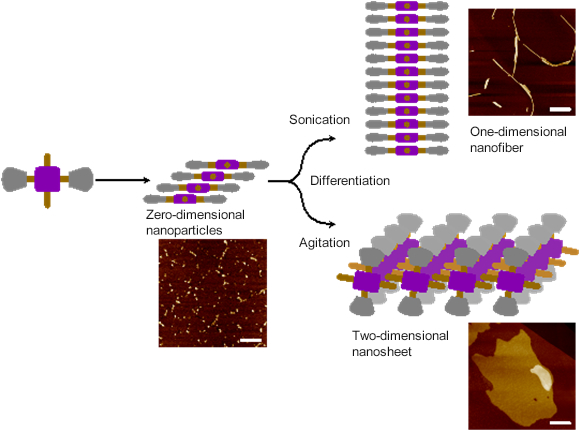Discovery and Control of Supramolecular Assembly Capable of Differentiation
—Selective Fabrication of Fibers and Sheets Accomplished, Leading to New Methods of Controlling Molecular Self-Assembly—
2016.12.20
National Institute for Materials Science (NIMS)
Shizuoka University
Kyoto University
A joint research team consisting of NIMS, Shizuoka University, and Kyoto University discovered “differentiation phenomena,” whereby a supramolecular assembly, resulting from a spontaneous assembly of molecules, can transform into either of two completely different structures, even though there was only a single initial state of the supramolecular assembly.
Abstract
- A NIMS research team led by senior researcher Kazunori Sugiyasu, Molecular Design & Function Group, Research Center for Functional Materials, and other researchers, including associate professor Shinnosuke Kawai, College of Science, Shizuoka University, and professor Shu Seki, Kyoto University, jointly discovered “differentiation phenomena,” whereby a supramolecular assembly, resulting from a spontaneous assembly of molecules, can transform into either of two completely different structures, even though there was only a single initial state of the supramolecular assembly. In addition, the joint research team succeeded in rendering the supramolecular assembly differentiation selectively into either a one-dimensional fiber assembly or a two-dimensional sheet assembly by adding different types of supramolecular assemblies as “seeds” to grow. Moreover, the length and area of supramolecular assemblies can be controlled by adjusting the amount of seeds. These results potentially promote the development of new methods for controlling molecular self-assembly in efforts to create new materials.
- The phenomena in which molecules assemble spontaneously (self-assembly) have been drawing attention from researchers who are considering a bottom-up approach to fabricate organic materials at the nanoscale. However, it is very difficult to gain full control of the self-assembly process, as the process spontaneously and forcefully advances toward a thermodynamically stable state. Moreover, attempts to create uniform materials from supramolecular assemblies had been fruitless due to their inconsistent sizes (length and area).
- Recently, the joint research team studied supramolecular assemblies that are metastable thermodynamically, and found that certain molecules can transform into two totally different structures even when their initial states are identical. This research revealed that what appear to be differentiation phenomena occur due to complex interactions taking place during the self-assembly process. Then, after gaining a better understanding of the mechanism of the phenomena, the team succeeded in controlling the length of nanofibers, which were one molecule wide, and the area of nanosheets, which were one molecule thick, by adding different types and quantities of supramolecular assemblies as seeds to grow. Furthermore, the team found that these one- and two-dimensional supramolecular assemblies have different electronic properties despite the fact that they are composed of the same molecules.
- The concept of self-assembly is attracting many interests as it is very important in diverse fields such as materials chemistry, nanotechnology, and biotechnology, and may inspire the development of new material synthesis methods. The findings from this research are expected to promote the invention of new methods for controlling self-assembly in efforts to create new materials. For example, these results may be applicable to the design of smart materials capable of fulfilling various functions through differentiation in response to time, place or situation as seen in biomolecular systems.
- This study was supported by Grants-in-Aid for Scientific Research projects on the innovative areas, titled “π-system figuration” and “Dynamical ordering of biomolecular systems for creation of integrated functions.” The study was also supported by Grants-in-Aid for Encouragement of Young Scientists (A), titled “Precise supramolecular polymerization for the manipulation of nonequilibrium systems .” All of these projects were sponsored by the Ministry of Education, Culture, Sports, Science and Technology.
- This research was published in the online version of the British scientific journal Nature Chemistry on December 20, 2016.

Figure. Self-assembling porphyrin molecules discovered in this study. All scale bars are 200 nm long.
Related files
- Research Center for Functional Materials
Contacts
(Regarding this research)
-
Kazunori Sugiyasu
Senior Researcher
Molecular Design and Function Group, RCFM, NIMS
Tel: +81-29-859-2110
E-Mail: SUGIYASU.Kazunori=nims.go.jp
(Please change "=" to "@")
(Regarding public relations)
-
Public Relations Office
National Institute for Materials Science
1-2-1 Sengen, Tsukuba, Ibaraki, 305-0047, JAPAN
Tel: +81-29-859-2026
Fax: +81-29-859-2017
E-Mail: pressrelease=ml.nims.go.jp
(Please change "=" to "@")
Same Keywords
-
Energy-Saving, Multicolor Electrochromic Dimming Glass: Proof-of-Concept in Tsukuba, Japan
(supramolecular)
2020.09.08
-
Stable Supply of Electrochromic Metallo-Supramolecular Polymer
(supramolecular)
2020.06.26
-
O2 Adsorption on a Platinum Surface Is Greatly Influenced by Its Molecular Alignment Relative to the Surface
(molecular)
2017.03.17
Recent Press Release
-
Simultaneous Imaging of Intracellular DNA and RNA Using Harmless Light
2025.10.27
-
Development of an AI Device Using Ion Gel and Graphene That Dramatically Streamlines Machine Learning Computations
2025.10.14
-
Demonstrating a Novel Method to Modulate Heat Flow Through the Collective Motion of Spins
2025.10.06
